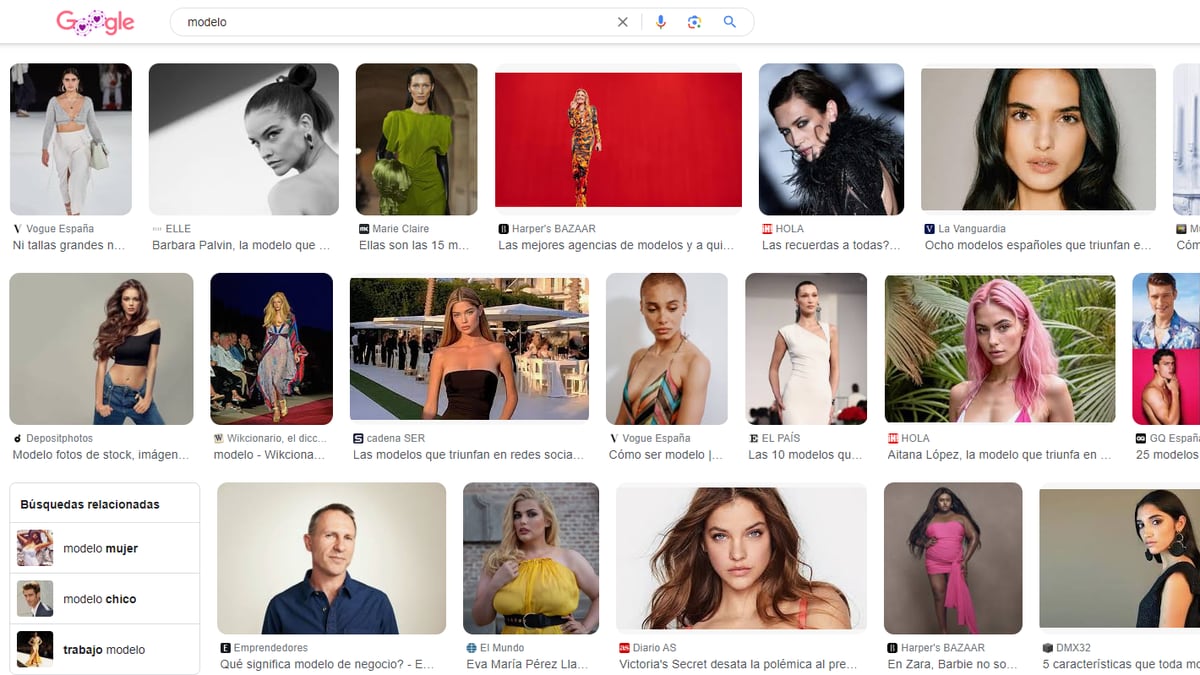The photos that appear after a search on Google Images of jobs such as cardiovascular surgeon, mathematician, developer, footballer, commissioner or investment banker are male.
And for a model, hairdresser, nurse, interior designer or art teacher they are women.
A study published this Wednesday by the journal
Nature
that analyzed 349,500 photos, 100 for each of the 3,495 most common social categories, observes a consistent gender bias on Google and other platforms such as Wikipedia and IMDB.
Until now, the most relevant studies analyzing these
online
prejudices have focused mainly on texts.
Researchers at the University of California at Berkeley believe that their finding is important due to the unstoppable increase in visual culture: reading time is reduced and entertainment on “hypervisual platforms focused on the exchange of images” grows, the article says.
The bias in online
images
is greater than that seen in surveys and real census data in the US. Although, according to Douglas Guilbeault, a professor at Berkeley and one of the authors, “a subtlety is that social groups and generations "They may differ in the type of visual content they produce and consume, and an important area for future research is to explore how this affects their experience."
Researchers have also found that bias in
online
images is more common than in text and its effects are more psychologically powerful.
At work they compared the images with text results from Google News.
Images show greater prejudice than texts and their impact is more lasting: people who saw an image with gender bias retained its influence for more days than those who read a text with a certain sexism.
“What surprises me most about the work is that a simple change, from textual to visual information, can have so many implications for the spread of gender bias, threatening decades of progress,” Guilbeault says.
More information
How to prevent artificial intelligence from failing women more in medical diagnoses
It is notable that the language used for the research is English, a language in which most professions are not distinguished by gender: there is no surgeon, just
surgeon
.
Photos, therefore, provide more information than text when seeing a male soccer player or a female hairdresser.
In Spanish, however, the distinction in language would also be evident.
But researchers have found effects that go beyond words themselves: “Various psychological research suggests that images could be an especially powerful means of transmitting gender biases.
“Research on the
image superiority effect
shows that images tend to be more indelible and emotionally impactful than text,” the article says.
The use of neutral terminology would be another advantage, which in Spanish is more complicated than in English.
Therefore, images on the internet amplify gender bias, both in their statistical figures and in their psychological impact on users.
How does bias arise?
The photos on the internet reproduce millions of choices by its users, who have created or uploaded those photos to their accounts and pages: “Gender bias seems to be partially driven by the content that internet users choose to display on their blogs. , as well as the preferences of audiences about what news to consume or what images to buy,” explains the research.
"Soccer player" is another search where the gender bias is very evident.
But how have the Internet's own mechanisms influenced this bias in online images?
“Bias may be intensified as a result of the network itself,” says Professor Bas Hofstra of Radboud University in the Netherlands, after analyzing the article before its publication.
“Perhaps user populations differ, perhaps men are the ones who have used or use the internet the most and, as such, it becomes a more gender-charged place,” he says.
The article also speculates that the status
or prejudices when hiring in media companies, whose photos are overrepresented on the Internet, may be another cause.
“Human preference for a familiar, prototypical representation of social categories is likely to play a role in perpetuating these biases,” the researchers say.
The consequence of this dynamic is to limit women's access to jobs in which they no longer have a place due to previous social dynamics.
But there could be more, according to Hofstra: “The way people talk about certain social categories, for example;
"There is more talk about men in relation to sports because more male athletes are seen
online
, which could decrease women's aspirations to enter that sport."
An obvious fear about the future that is only mentioned in the article that the images of the current internet are one of the main bases of generative artificial intelligence (AI): “Images created with AI can make the internet a place more loaded with sexism if they are based on already generated images that are
online
,” says Hofstra.
“Our work suggests that gender biases in AI may be due in part to the fact that they are trained with public images from platforms such as Google and Wikipedia, which are full of gender biases,” the study provides.
It is difficult to think of concrete solutions to this problem.
Google may be giving biased results because the requests or information already existing on the internet is biased.
“Solutions will have to emerge from technology, academics and civil society,” says Guilbeault.
“Our research aims to start a critical conversation about the implications of changing the visual for the spread of gender bias.
The methods and tools we have created are an important step toward transparency of information about the changing landscape of
online
bias , which is a necessary step to discovering solutions.”
You can follow
EL PAÍS Tecnología
on
and
X
or sign up here to receive our
weekly newsletter
.
Subscribe to continue reading
Read without limits
Keep reading
I am already a subscriber
_

